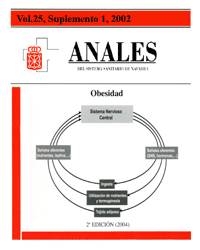El tejido adiposo: órgano de almacenamiento y órgano secretor
DOI:
https://doi.org/10.23938/ASSN.0812Palabras clave:
Obesidad. Índice de Masa Corporal. Clasificación.Resumen
La obesidad es una enfermedad crónica que se caracteriza por un aumento de la masa grasa y en consecuencia por un aumento de peso. Existe, pues, un aumento de las reservas energéticas del organismo en forma de grasa. El término crónico se le aplica debido a que forma parte del grupo de enfermedades que no podemos curar con el arsenal terapéutico del que se dispone en la actualidad. Desde un punto de vista antropométrico, que es el habitualmente utilizado en clínica, se considera obesa a una persona con un Índice de Masa Corporal igual o superior a 30 kg/m2. Para poder valorar la obesidad se deben tener en cuenta no sólo los aspectos antropométricos sino también los posibles factores genéticos; hay que investigar las causas de la enfermedad y comprobar la posible existencia de complicaciones y enfermedades asociadas. El tratamiento siempre deberá ser personalizado y adaptado a las características y a las comorbilidades que presente el enfermo. Los criterios dominantes favorables a la intervención terapéutica en la obesidad se basan, especialmente, en la demostración de que con una pérdida moderada de peso corporal (5-10%) se puede conseguir una notable mejoría en la comorbilidad asociada a la obesidad y en la calidad de vida del paciente obeso.Descargas
Descargas
Publicado
Cómo citar
Número
Sección
Licencia
La revista Anales del Sistema Sanitario de Navarra es publicada por el Departamento de Salud del Gobierno de Navarra (España), quien conserva los derechos patrimoniales (copyright ) sobre el artículo publicado y favorece y permite la difusión del mismo bajo licencia Creative Commons Reconocimiento-CompartirIgual 4.0 Internacional (CC BY-SA 4.0). Esta licencia permite copiar, usar, difundir, transmitir y exponer públicamente el artículo, siempre que siempre que se cite la autoría y la publicación inicial en Anales del Sistema Sanitario de Navarra, y se distinga la existencia de esta licencia de uso.








